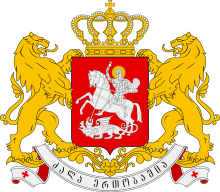
Back Armes parlants Catalan Mluvící znamení Czech Talende våben Danish Redendes Wappen German Laŭnomaj blazonoj Esperanto Armas parlantes Spanish Kõnelev vapp Estonian نام-نشان خاندان Persian Puhuva vaakuna Finnish Armes parlantes French
This article needs additional citations for verification. (August 2011) |


Canting arms are heraldic bearings that represent the bearer's name (or, less often, some attribute or function) in a visual pun or rebus.
The expression derives from the latin cantare (to sing). French heralds used the term armes parlantes (English: "talking arms"), as they would sound out the name of the armiger. Many armorial allusions require research for elucidation because of changes in language and dialect that have occurred over the past millennium.
Canting arms – some in the form of rebuses – are quite common in German civic heraldry. They have also been increasingly used in the 20th century among the British royal family.[citation needed] When the visual representation is expressed through a rebus, this is sometimes called a rebus coat of arms.[citation needed] An in-joke among the Society for Creative Anachronism heralds is the pun, "Heralds don't pun; they cant."[2]
- ^ "Tinctures". www.heraldica.org.
- ^ Neznanich, Modar. "Heraldry for Those Who Cant" (PDF). Retrieved 2 July 2012. Cites 72 historical examples of canting arms, as well as SCA usage.
© MMXXIII Rich X Search. We shall prevail. All rights reserved. Rich X Search